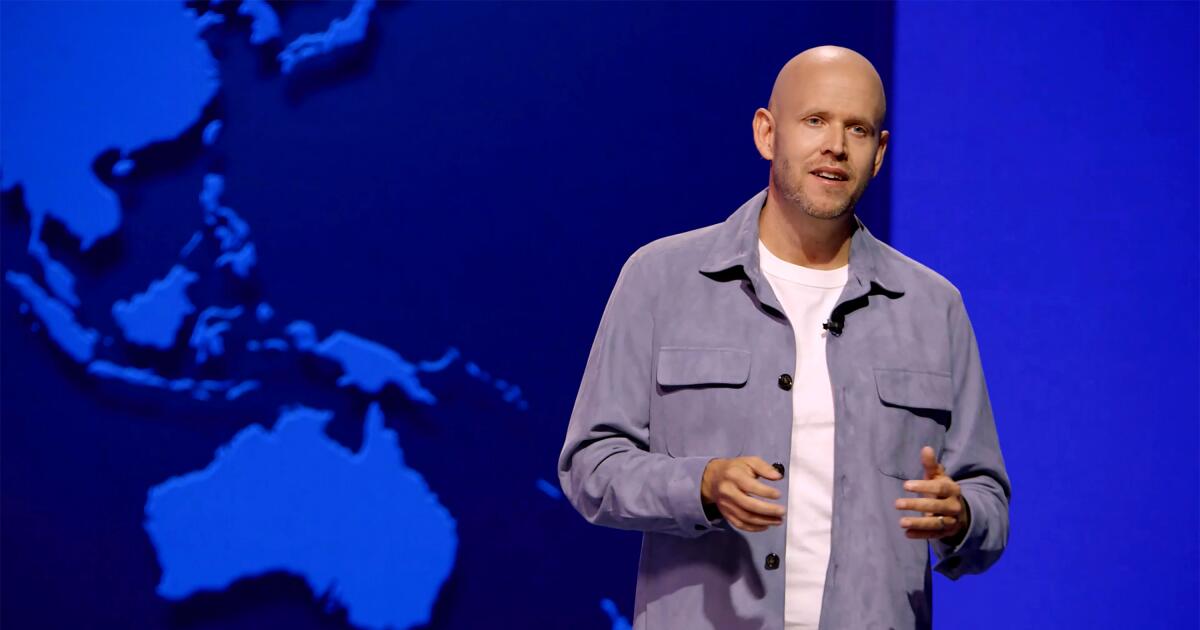
As a long-time user and ardent supporter of Spotify, I am thrilled to see the company’s ambitious expansion into video content. Having grown up with Spotify as my go-to music streaming platform, I have witnessed its evolution from a simple music service to a multifaceted entertainment hub. The addition of video podcasts and now ad-free videos for premium users is a testament to their commitment to innovation and user satisfaction.
In a bid to boost its rivalry with prominent digital platforms like YouTube, Instagram, and TikTok, the Swedish streaming audio leader Spotify is attracting more video creators, podcasters, and social media influencers.
On Wednesday, a Stockholm-based firm invited content creators to their Downtown L.A.’s Arts District office, where executives showcased upcoming features designed to assist video makers in boosting their income from their content and monitoring its performance on the streaming platform. The company is introducing a new initiative aimed at helping creators increase their earnings from advertising and subscriptions, as announced by Spotify.
In the near future, Spotify Premium users will enjoy watching videos without any advertisements. This change is a response to video podcasters who have expressed frustration over excessive commercial breaks in their programs, which may annoy paying subscribers. Qualified content creators stand to earn revenue based on the number of times ad-free videos are streamed.
During the event, Spotify’s Co-President and Chief Product and Technology Officer, Gustav Söderström, stated that financial success and the quality of a show are no longer at odds; instead, they have a positive connection with each other.
Starting in January, premium users in the U.S., U.K., Australia, and Canada can enjoy ad-free videos. If you prefer not to subscribe, you can continue listening to music, podcasts, and audiobooks with advertisements on Spotify. It’s worth noting that video creators receive a portion of these advertising revenues. Additionally, for premium users, audio-only podcasts will still contain ads.
Originally a music streaming service, Spotify ventured into podcasting five years ago by acquiring podcast companies and securing exclusive agreements with prominent figures like Joe Rogan and Alex Cooper. This move broadened Spotify’s services, but the company later scaled back on some costly deals due to overspending. Subsequently, they revised their podcast strategy and let go of some employees.
But podcasts remain a big draw for the service. Spotify has also added audiobooks to its catalog.
In 2020, Spotify expanded its video-based content by enabling podcasters to post videos of their discussions and chats. Now, over 300,000 video podcast series are available on Spotify, as stated by the company.
According to Spotify, over 250 million users have listened to video podcasts on their platform. Additionally, the number of content creators uploading videos monthly has increased by more than 50% when compared to the same timeframe last year.
Encouraging additional video content creators might keep users engaged for longer periods on our platform. This prolonged engagement could potentially lower the rate at which we lose subscribers (churn), boost ad revenue, and draw in new clientele.
Additionally, this move positions Spotify more favorably against YouTube, as YouTube already divides advertising and subscription income among video creators. YouTube’s platform offers free access to its extensive video library with ads, along with YouTube Premium, a subscription service starting at $13.99 per month, which provides ad-free access to both YouTube and YouTube Music.
Previously this year, YouTube reported surpassing 100 million users for its Premium service, taking into account both paid and trial accounts. It’s worth noting that the free, advertisement-supported version of YouTube boasts a user base in the billions.
In Q3, Spotify announced they had 640 million monthly active listeners, marking an 11% increase compared to the same period last year. Additionally, Spotify Premium currently boasts 252 million paid subscribers.
On a recent earnings call, I, as Spotify’s Chief Executive Daniel Ek, countered the notion that our scale, reach, and engagement are smaller compared to YouTube’s by suggesting that the idea of a “winner-takes-all” dynamic oversimplifies things. Instead, what creators truly desire is the opportunity to be present on numerous platforms.
According to Ek’s statement, our understanding from podcasting is being reinforced, and we are focusing on this approach. He also mentioned that there are numerous content creators on Spotify who share only portions of their work, as well as new creators whose needs we haven’t met yet.
According to Spotify’s leaders, there’s still potential for the business to expand even further. On Tuesday, they announced their expectation of recording a full-year profit in 2024, marking the first time in its history that Spotify would have a profitable year.
Read More
- Clash Royale Best Boss Bandit Champion decks
- Chuck Mangione, Grammy-winning jazz superstar and composer, dies at 84
- Clash Royale Furnace Evolution best decks guide
- Riot Games announces End of Year Charity Voting campaign
- Clash Royale Witch Evolution best decks guide
- Mobile Legends November 2025 Leaks: Upcoming new heroes, skins, events and more
- King Pro League (KPL) 2025 makes new Guinness World Record during the Grand Finals
- Deneme Bonusu Veren Siteler – En Gvenilir Bahis Siteleri 2025.4338
- Clash Royale Season 77 “When Hogs Fly” November 2025 Update and Balance Changes
- Tourism Malaysia Eyes Esports Boom: Director General Highlights MLBB M6 World Championship and Future Opportunities
2024-11-14 02:01